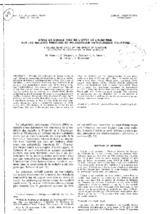Étude en double insu de l'effect de l'almitrine sur les malades porteurs de polyglobulie pathologique d'altitude

View/
Date
1985Author
Villena, M
Vargas, E
Guénard, H
Nallar, N
Tellez, W
Spielvogel, H
Metadata
Show full item recordAbstract
ABSTRACT.
Chronic polycythaemia in people living at high altitude is associated with hypoxaemia due to a marked reduction in hypoxic and hypercapnie drives. The effect of almitrine, a chemoreceptor stimulant, was evaluated in 40 patients, with haematocrit values over 57 %, living in La Paz (3,600-4,000 m). Two studies were carried out. The aim of the first was to assess the ventilatory response, and the increase in Pao₂, due to almitrine in a double blind, placebo controlled protocol including 40 patients (mean haematocrit 66.8%). Almitrine was given orally at a dose of 3 mg. kg-1. Variance analysis showed that three hours later there was a significant increase in Pao₂, (+ 0.46 kPa), pH and respiratory frequency, with a significant reduction in Paco₂, (-- 0.4 kPa). The increase in ventilation (+ 17 %) was not significant. The aim of the second study was to assess the effect of almitrine on the polycythaemia. It was given orally at a dose of 1.5 mg• kg-1. day-1 to twelve patients over a four week period. Blood gases, ventilation (VE), oxygen consumption (VO₂), carbon dioxide production (VCO₂) and haematocrit were measured every week. There was a slight but significant reduction in haematocrit (-- 3.5 %). Pao₂, and all the other measured parameters (VE, Paco₂, pH, VO₂ Vco₂,) remained constant. The reduction in haematocrit was not therefore due to an increase in diurnal Pao₂, but is perhaps due to the improvement in pulmonary ventilation during sleep.
